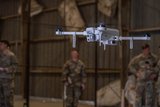Biden issues new Indo-Pacific Strategy
The US is cognisant that it needs to bring like-minded allies together to counter regional security threats. (Gordon Arthur)
The White House released its Indo-Pacific Strategy on 11 February, the first under President Joe Biden’s administration, and three years after Donald Trump released his version.
Significantly, the White House published Biden’s strategy, whereas Trump did so under the DoD. The latter fuelled Asian concerns that Washington DC was over-militarising its Indo-Pacific policy.
Another point of difference is that Trump nested his Indo-Pacific Strategy within the National Security Strategy and National Defense Strategy, which were released just before it. Biden has not done so.
Biden has carried on the trajectory launched by Trump, that of a more ardent stance against
Already have an account? Log in
Want to keep reading this article?
More from Defence Notes
-
![What will next-gen counter-UAS capabilities for the US look like?]()
What will next-gen counter-UAS capabilities for the US look like?
Future US counter-uncrewed aerial system solutions are likely to require a flexible, multi-layered approach to tackle a broad spectrum of new threats as they emerge.
-
![Elbit Systems awarded $2.3 billion contract as results soar]()
Elbit Systems awarded $2.3 billion contract as results soar
The company’s order backlog as of 30 September totalled $25.2 billion and more than a third of this is scheduled to be fulfilled before the end of 2026.
-
![US military foresees growing use of 3D printing]()
US military foresees growing use of 3D printing
Advanced manufacturing has evolved to meet military requirements and now supports multiple US critical assets, including Arleigh Burke-class destroyers, F-18, F-22, F-35, Bradley, HMMWV and Patriot.
-
![Irish Naval Service expands as the country looks to defence during EU presidency]()
Irish Naval Service expands as the country looks to defence during EU presidency
The Irish Naval Service has struggled to maintain capability, particularly in the face of lucrative private sector offers luring away personnel.
-
![Resilience, adaptiveness and collaboration vital for success in space (Studio)]()
Resilience, adaptiveness and collaboration vital for success in space (Studio)
Speakers at the Defence In Space Conference (DISC) 2025 highlighted the critical and evolving role of space in national security, defence and the global economy.

























